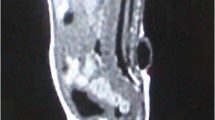Abstract
This study shows that there is a relationship between simple meningocele and the tethered cord syndrome. Two groups of patients were examined: the first comprised patients presenting with neurological abnormality at some period after initial closure of a simple meningocele, and the second group (18 patients) had elective myelography after closure of a simple meningocele in the neonatal period (in 17 of the 18 cases). Of these 18 cases, 10 showed an intradural abnormality, and all underwent surgery confirming their myelographic diagnosis. The conclusion is drawn that after closure of a simple meningocele in the neonatal period, patients should have elective myelography in the first 12 months of life to determine whether or not the tethered cord syndrome is likely to develop during the period of growth.
Similar content being viewed by others
References
Brieg A (1970) Overstretching of and circumscribed pathological tension in the spinal cord — a basic cause of symptoms in cord disorders. J Biomech 3:7–9
Fitz CR, Harwood-Nash DC (1975) The tethered conus. AJR 125:515–523
Garceau GJ (1953) The filum terminale syndrome (the cord traction syndrome). J Bone Joint Surg 35:711–716
Heinz ER, Rosenbaum AE, Scarff TB, Reigel DH, Drayer BP (1979) Tethered spinal cord following myelomeningocele repair. Radiology 131:153–160
Hoffman HJ, Hendrick EB, Humphreys RP (1976) The tethered spinal cord: its protean manifestations, diagnosis and surgical correction. Child's Brain 2:145–155
James CCM, Lassman LP (1972) Spinal dysraphism. Butterworths, London
Jones PH, Love JG (1956) Tight filum terminale. Arch Surg 73:556–566
Matson DD (1969) Neurosurgery of infancy and childhood. Thomas, Springfield, Ill
Till K (1969) Spinal dysraphism: a study of congenital malformations of the lower back. J Bone Joint Surg [Br] 51:415–422
Till K (1975) Paediatric neurosurgery. Blackwell, London
Yamada S (1981) Pathophysiology of the tethered cord syndrome. J Neurosurg 54:493–503
Author information
Authors and Affiliations
Rights and permissions
About this article
Cite this article
Chaseling, R.W., Johnston, I.H. & Besser, M. Meningoceles and the tethered cord syndrome. Child's Nerv Syst 1, 105–108 (1985). https://doi.org/10.1007/BF00706690
Issue Date:
DOI: https://doi.org/10.1007/BF00706690




